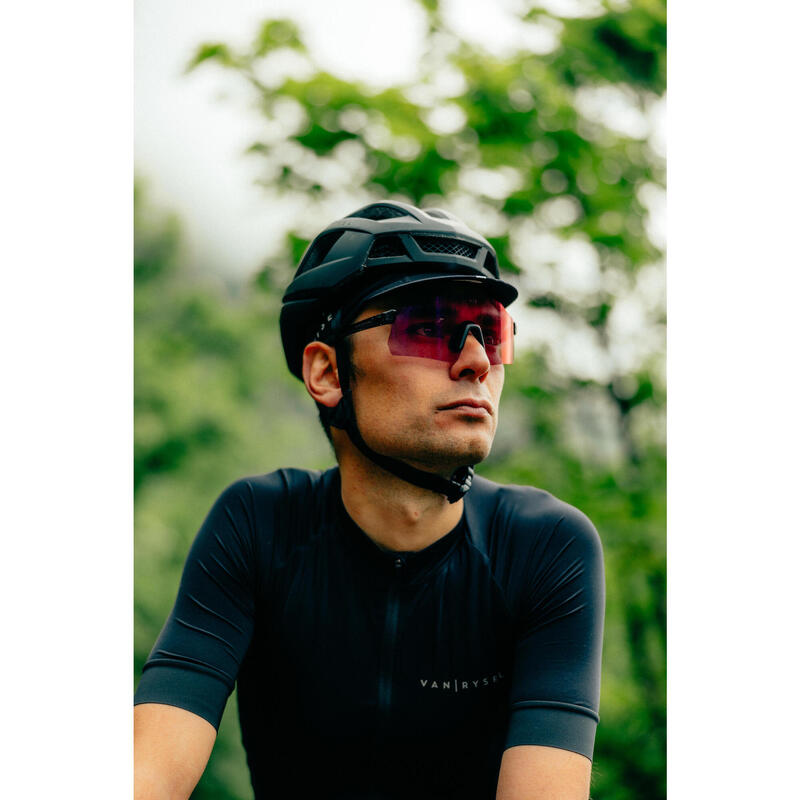1. TESTS CARRIED OUT WITH DECATHLON SPORTSLAB
This saddle comes in two different sizes: 145 mm and 155mm. We therefore carried out tests in collaboration with our research and development laboratory: Decathlon Sportslab. The aim of the study was to be able to recommend the right saddle size according to ischial bone spacing for both men and women who ride road bikes several times a week.
2. HOW TO CHOOSE THE RIGHT SADDLE WIDTH?
For ischial widths between 90 and 120 mm, the 145mm saddle is preferable.
For ischial widths between 120 and 140 mm, the 155mm saddle is preferable.
If you have a more upright position on your bike (with a back angle between 45° and 60°), you can opt for the widest saddle, i.e. 155 mm. This will provide you with less discomfort during your outings.
3. HOW TO MEASURE ISCHIAL WIDTH?
Materials required: 2 corrugated cardboard boxes, a stool (with a flat surface), a ruler, a pen.
1. Position the two corrugated boards one on top of the other.
2. Sit on the stool with your back straight. Then exert force on the stool by pulling upwards for 1 minute.
3. Stand up and locate the points that represent the imprint of your ischial bones on the cardboard.
4. Identify the center of these two imprints and draw a line connecting the two points.
WATCH THE VIDEO TUTORIAL TO MEASURE YOUR ISCHIAL WIDTH
You can also watch our tutorial video, which explains all the above steps: https://players.brightcove.net/3415345270001/DOHosj6Wy_default/index.html?videoId=ref:p2575062_1
TO MAKE THE MOST OF YOUR CYCLING TRIP:
- Choose a saddle adapted to your back position on the bike (in this case, we prefer a 30° back angle saddle)
- Determine the saddle height
- Adjust the saddle inclination
- Adjust the saddle advance (or saddle retreat)
To get the most out of your outings, remember to wear cycling shorts adapted to the duration of your activity.
Here are the instructions for the bike adjustment steps:
https://players.brightcove.net/3415345270001/DOHosj6Wy_default/index.html?videoId=ref:p2263569_1
1. DETERMINING SADDLE HEIGHT (part 1)
Materials required: tape measure, book and pencil.
a. Stand with your bare feet against the wall. Your feet are slightly apart (approx. 15-20 cm max.) and your heels are touching the wall. Look straight ahead.
b. Next, place the book against the wall and slide it between your legs to your perineum: apply a little force to imitate the pressure of the saddle.
1. DETERMINE SADDLE HEIGHT (part 2)
c. Measure the distance from the top of the book to the ground and transfer this measurement to your bike. Then multiply the value you get by x0.883.
(Ex: you get 89 cm so you need to do 89 x 0.883 = 78.6 cm. This means that from the center of your saddle to the center of your crankset, there must be 78.6 cm.)
2. ADJUST SADDLE INCLINATION
To do this, set the inclination flat using a spirit level, which you will position on the front of the saddle (from the center of the saddle to the tip).
We advise you to take a few rides to find the right saddle inclination setting.
3. ADJUST SADDLE ADVANCE (OR SADDLE RETRACT)
Saddle forward motion (or saddle backward motion) is very important, as it will enable you to be more efficient during your outings and limit discomfort.
a. Sit on your bike against a wall, for example
b. Clip your cycling shoes onto the pedals and position the crank parallel to the ground (horizontal).
c. The pedal axle should then be aligned with the front of your knee (neither too far forward nor too far back).
DIMENSIONS
Saddle width and length: 155 mm x 250 mm
Rail size: 7 mm x 7 mm










